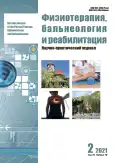Psychoemotional motivation of motor act development (pilot study)
- 作者: Nizhelskoy V.A.1,2, Zaytseva T.N.3, Gerasimenko M.Y.3
-
隶属关系:
- Lomonosov Moscow State University
- Anokhin Research Institute of Normal Physiology
- Russian Medical Academy of Continuing Professional Education
- 期: 卷 20, 编号 2 (2021)
- 页面: 89-98
- 栏目: Original studies
- URL: https://journals.rcsi.science/1681-3456/article/view/89992
- DOI: https://doi.org/10.17816/1681-3456-2021-20-2-1
- ID: 89992
如何引用文章
详细
BACKGROUND: In clinical practice, video motion analysis is widely used. It is known that such a higher mental function as creative thinking manifests itself in the motor activity of the body, as a result of which the movement becomes expressive. Since the quality of the images presented affects the organization of movement, it is presumably possible to characterize this psychosomatic connection through an assessment of the expressiveness of movement.
AIMS: fixation in graphic and digital format of expressive movement, as well as the identification of spatio-temporal criteria for the quantitative assessment of expressiveness.
MATERIAL AND METHODS: The experiment involved 3 healthy volunteers with different levels of acting training. The structure of expressive movement was presented in a graphic and digital format, which made it possible to calculate spatio-temporal indicators and give an objective quantitative assessment of the quality of expressiveness of movements of the participants in the experiment.
RESULTS: It has been established that expressive movements arise with the integration of the following components: motor abilities and motor experience, movement image, plastically expressive structure of movement construction. In addition, expressive movements affect deep psychological functions: imagination, creative thinking, emotional control, etc.
CONCLUSION: The inclusion in the course of medical rehabilitation of patients with various pathologies of the direction of ergotherapy, based on the analysis and assessment of the expressiveness of movement, will contribute to the complex restoration of the connection between consciousness and movement, correction of psychosomatic deviations, the expansion of movement patterns, improvement of body feeling and movement control.
作者简介
Viktor Nizhelskoy
Lomonosov Moscow State University; Anokhin Research Institute of Normal Physiology
编辑信件的主要联系方式.
Email: viktor-nij@mail.ru
ORCID iD: 0000-0001-7506-5480
SPIN 代码: 2890-3053
MD
俄罗斯联邦, Moscow; MoscowTatiana Zaytseva
Russian Medical Academy of Continuing Professional Education
Email: viktor-nij@mail.ru
ORCID iD: 0000-0001-7123-1568
SPIN 代码: 9416-4428
MD, Cand. Sci. (Med.)
俄罗斯联邦, MoscowMarina Gerasimenko
Russian Medical Academy of Continuing Professional Education
Email: viktor-nij@mail.ru
ORCID iD: 0000-0002-1741-7246
SPIN 代码: 7625-6452
MD, Dr. Sci. (Med.), Professor
俄罗斯联邦, Moscow参考
- Skvortsov DV. The methods of investigation of kinematics and modern standards. Videoanalysis. Lechebnaya fizkul'tura i sportivnaya meditsina. 2012;(12):4–10. (In Russ).
- Mitrakov NN, Shcherbukha AV, Shafran PA, et al. Prospects for the use of motion video analysis for the diagnosis of motor disorders and monitoring the effectiveness of motor rehabilitation in children receiving complex treatment of acute lymphoblastic leukemia. Russian Journal of Pediatric Hematology and Oncology. 2019;6(S1):139. (In Russ).
- Krishnan C, Washabaugh EP, Seetharaman Y. A low cost real-time motion tracking approach using webcam technology. J Biomech. 2015;48(3):544–548. doi: 10.1016/j.jbiomech.2014.11.048
- Borzikov VV, Rukina NN, Vorobyova OV, et al. Video analysis of human movements in clinical practice (review). Sovremennyye tekhnologii v meditsine. 2015;7(4):201–210. (In Russ).
- Likhachev SA, Lukashevich VA. Video analysis of stepping movement: the phenomenology of visual assessment. International Journal of Neurology. 2012;(2):178–182. (In Russ).
- Bernshteyn NA. O About construction of movements. Moscow: Gosudarstvennoe izdatel'stvo meditsinskoy literatury; 1947. 254 p (In Russ).
- Bernshteyn NA. Essays on the physiology of movements and the physiology of activity. Lechebnaya fizkul'tura i sportivnaya meditsina. 2012;(1):4–9. (In Russ).
- Nizhel'skoy VA, Kovaleva AV, Panova YeN. Impact of perceiving sense-oriented images on the parameters of the vertical posture and brain activity in actors during method acting (pilot study). National Psychological Journal. 2020;2(2):148–157. (In Russ).
- Skvortsov DV. Some research results of N.A. Bernstein in the light of modern data. Lechebnaya fizkul'tura i sportivnaya meditsina. 2012;(10):4–10. (In Russ).
- Bonnet V, Sylla N, Cherubini A, et al. Toward an affordable and userfriendly visual motion capture system. Conf Proc IEEE. Eng Med Biol Soc. 2014;2014:3634–3637. doi: 10.1109/EMBC.2014.6944410
- Lin HI, Lin YH. A novel teaching system for industrial robots. Sensors (Basel). 2014;14(4):6012–6031. doi: 10.3390/s140406012
补充文件











